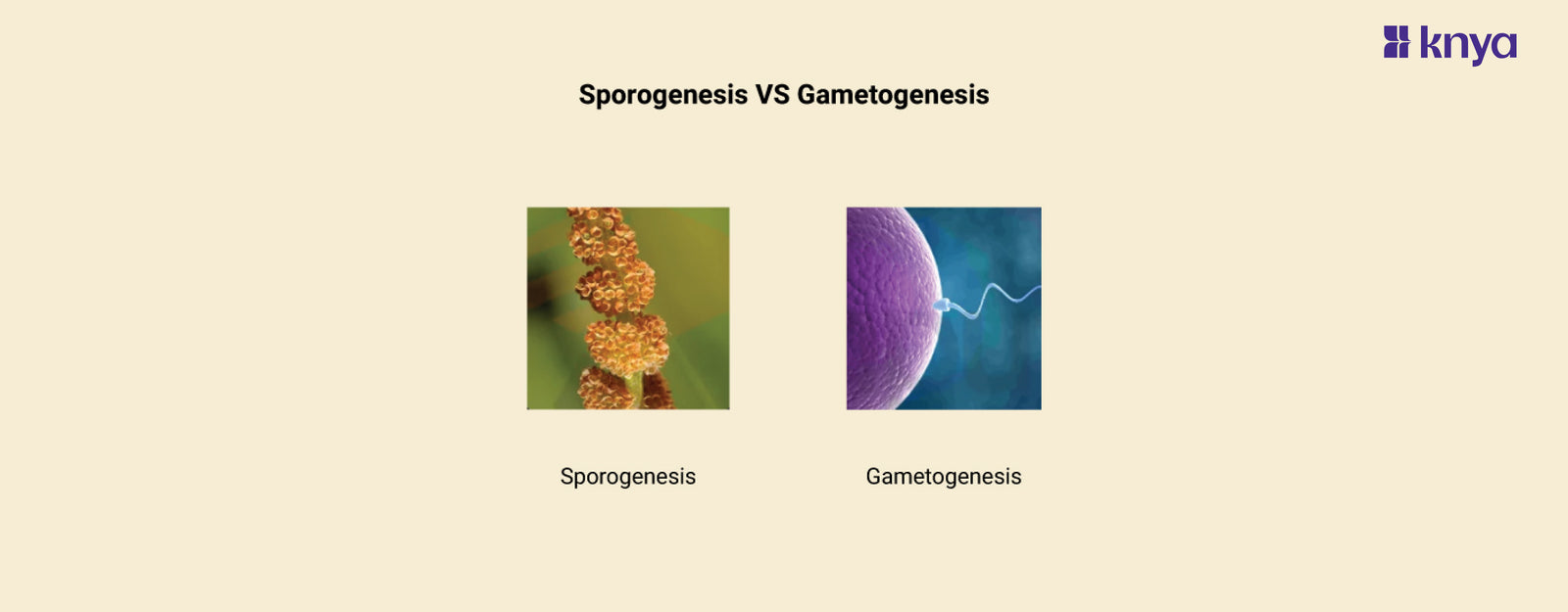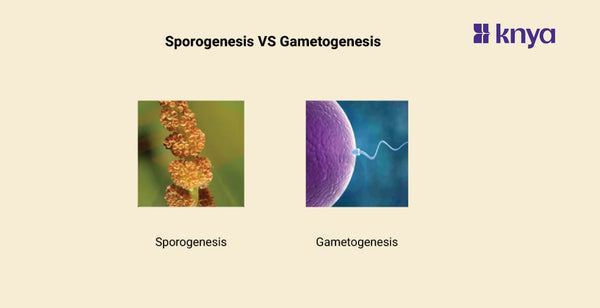Difference Between Sporogenesis and Gametogenesis: Sporogenesis and Gametogenesis are two critical phases of sexual reproduction, yet they differ significantly. Sporogenesis, which occurs in flowers, anthers, and ovules, is the process of producing haploid spores (microspores and megaspores) via meiosis. Gametogenesis then converts the spores into mature gametes (sperm and egg) for fertilisation. Essentially, sporogenesis creates the raw materials (spores), and gametogenesis refines them into the sex cells required for reproduction.
Difference Between Sporogenesis and Gametogenesis
Sporogenesis and gametogenesis are both essential processes in the life cycles of organisms, particularly in plants and some animals. Here's an overview of each followed by the differences Between the two:
|
Aspect |
Sporogenesis |
Gametogenesis |
|
Definition |
Formation of spores (reproductive cells) in plants |
Formation of gametes (sperm and egg) in organisms |
|
Occurrence |
Primarily in plants |
Occurs in both plants and animals |
|
Starting cells |
Sporophyte cells |
Germ cells |
|
Purpose |
Asexual reproduction |
Sexual reproduction |
|
End products |
Spores |
Gametes |
|
Ploidy level |
Usually haploid |
Haploid |
|
Process complexity |
Less complex |
More complex |
|
Formation location |
Often occurs in sporangia or specialized structures |
May occur in specialized gonads or organs |
|
Genetic variation |
Limited genetic variation due to asexual reproduction |
Significant genetic variation due to genetic recombination |
|
Role in life cycle |
Often involved in dispersal and survival |
Essential for sexual reproduction and genetic diversity |
Order the Best Jogger Scrub from Here!
What is Sporogenesis?
Sporogenesis is the initial stage in the development of plant sex cells. It occurs in both male and female plant parts and requires the division of a specific cell through meiosis to create haploid spores. These spores are classified as microspores in male anthers and megaspores in female ovules.
Browse Best Scrubs Collection
Key Features of Sporogenesis:
- This process begins with a diploid cell going through a unique form of cell division known as meiosis. However, unlike normal meiosis, which generates gametes, this meiosis only includes one cycle of mitotic division. This produces four haploid spores that are genetically identical to the parent cell.
- The final outcome of sporogenesis is four haploid spores. These spores can grow into new individuals either by mitosis (in certain plants) or through further germination and mitotic divisions.
- Sporogenesis is an example of asexual reproduction. Because the spores are genetically identical to the parent, the kids inherit all attributes from the parent generation.
- Example: Spores are typically found in plants such as ferns and moss. Fungi also reproduce via spores. These spores may quickly propagate by air and water, aiding in the spread of the organism.
What is Gametogenesis?
The second stage is gametogenesis, which uses the haploid spores from sporogenesis to produce the real gametes, or sex cells, needed for reproduction. Gametogenesis in male pollen grains (which originate from microspores) includes mitosis to produce sperm. Gametogenesis occurs in the female embryo sac (which develops from a megaspore) and includes additional mitosis to form the egg cell. These gametes (sperm and egg) will ultimately unite during fertilisation, resulting in a new diploid creature.
Explore All Women's Scrub
Key Features of Gametogenesis:
- Gametogenesis involves meiosis, but unlike sporogenesis, it requires two rounds of meiotic division. This mechanism shuffles genetic information, producing four haploid gametes (sex cells) with distinct genetic combinations.
- Gametogenesis produces both sperm (in men) and eggs (in females). These gametes are haploid, with just half as many chromosomes as the parent cell.
- Gametogenesis is necessary for sexual reproduction. Fertilisation happens when a sperm combines with an egg to form a diploid zygote, which grows into a new creature with a distinct genetic makeup.
- Example: Gametogenesis is essential for all sexually reproducing species, including humans and plants that rely on pollen and ovules to reproduce.
Shop Best Lab Coats from Here!
Similarities Between Sporogenesis and Gametogenesis
- Sporogenesis and Gametogenesis Both mechanisms are necessary for organismal reproduction and survival.
- Both need cellular differentiation and development.
- Both may use meiosis to generate haploid cells.
- Both are affected by external influences and internal regulating systems.
- Both occur in specialised structures or organs of the organism's body.
Sporogenesis and gametogenesis are two critical processes in sexual reproduction in plants and animals, although they have different functions. Sporogenesis is the process by which diploid spore mother cells undergo meiosis and produce haploid spores. The spores can then germinate and grow into multicellular gametophytes. In contrast, gametogenesis refers to the direct creation of gametes, or sex cells, from haploid spores. Gametes are likewise haploid, but unlike spores, they are designed for fertilisation and carry just half the genetic information required to create a new creature. Thus, the primary distinction between sporogenesis and gametogenesis is in the final product: sporogenesis creates spores for continued growth, whereas gametogenesis produces sex cells ready for fusing and the formation of a new generation.
| Check out More Articles | |
| Difference Between Cartilage And Bone | |
| Difference Between Endocrine And Exocrine Glands | |
| Difference Between Cell Wall And Cell Membrane | |















